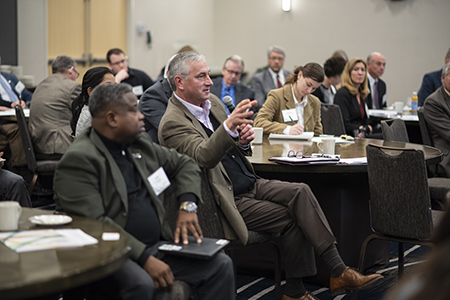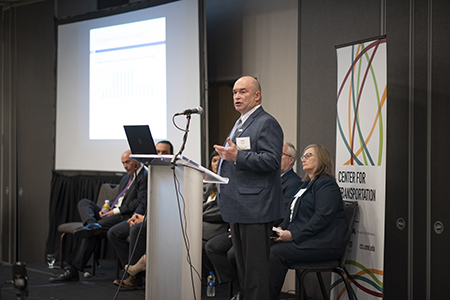In a changing climate, extreme weather patterns have become a major concern for transportation professionals. Preparing transportation infrastructure to weather these changes is a major challenge. In addition, natural disasters are becoming more common and more severe across the country, and the system for rebuilding after disasters needs improvement.
Symposium panelist Jeffrey Meek, sustainability coordinator at the MnDOT Office of Sustainability and Public Health, gave an overview of MnDOT efforts to understand and mitigate the effects of climate change on our road systems.
As the world’s climate shifts, he said, Minnesota will begin to see changes in precipitation and freezing patterns. Data from the Minnesota Department of Natural Resources has already shown a distinct increase in average annual precipitation, particularly in southeastern Minnesota, and average winter temperatures are on the rise.
“This is significantly impacting our road system,” Meek said.
Increased precipitation means increased flooding and more damage to roads and bridges. Warmer winters mean that roads will spend more time hovering just above and below freezing temperatures: a perfect recipe for potholes. “That’s what we’ve already seen to date,” Meek said, “and we’re going to see more of that.”
Beyond Minnesota, the effects of climate change can be seen in the form of wildfires and hurricanes, both of which are increasing in frequency and severity, according to the National Oceanic and Atmospheric Administration.
In order to adapt to these threats, cities and road systems will need to be built with resilience in mind. But symposium speaker Bethany Stich, director of the University of New Orleans Transportation Institute, pointed out that there’s a problem with the federal system for disaster relief funding. FEMA uses a “replace-in-kind” policy, which dictates that damaged roads, buildings, and other structures be rebuilt as they were before the disaster. This ultimately means that cities with problematic infrastructure cannot make alterations for increased resilience.
Stich decried the waste in rebuilding in a way that is known to be problematic. “We know we have a broken system,” she said.
Fortunately, climate resilience is beginning to gain priority among infrastructure planners. In July, the U.S. Senate introduced the America’s Transportation Infrastructure Act of 2019, which, among other things, aims to kick-start several new climate-related grant programs and expand the flexibility and eligible uses of the Highway Trust Fund.
“On the federal level, there's a lot more attention being paid to resilience—especially as it pertains to supply chains—than there has been in the past,” said symposium panelist Mark Berndt, freight planning practice leader with Quetica Consulting and Engineering.

